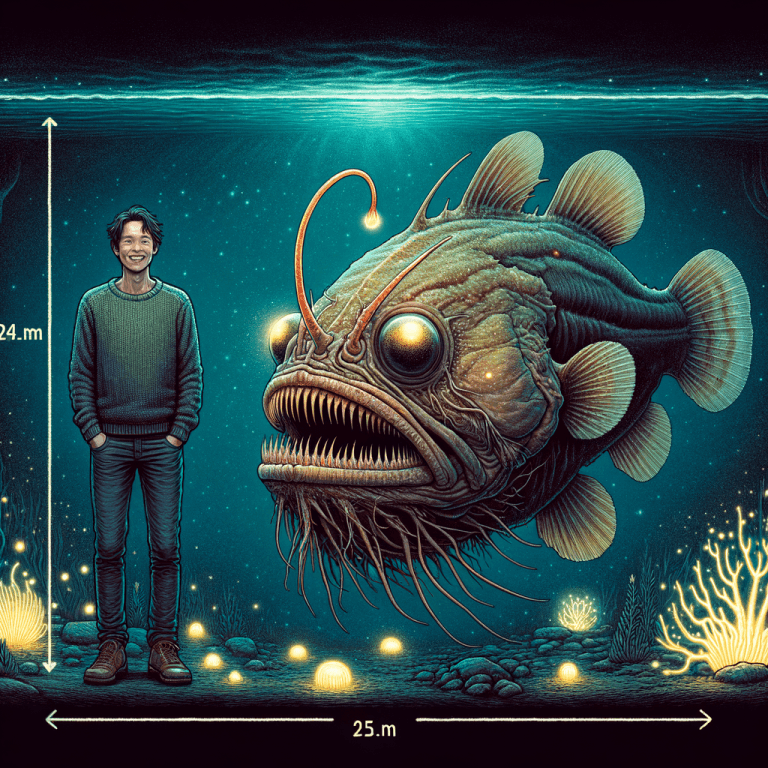Understanding the Angler Fish
When comparing the size of the angler fish to a human, it’s hard to imagine the vast difference in length and weight. The angler fish’s habitat and behavior also play a crucial role in its survival, making it a fascinating creature to study. Exploring the unique features of the angler fish compared to other deep-sea species sheds light on its significance in the marine ecosystem.
Discovering the Astonishing Size Difference Between Angler Fish and Humans
If you’ve ever wondered just how big an angler fish is compared to a human, you’ll be amazed by the surprising findings in this article. From their weight to their height, the comparison will leave you in awe of the incredible diversity of life on our planet.
Angler Fish Size
When it comes to the size of the angler fish, there are several key points to consider. Let’s take a closer look at the average length and weight of the angler fish, sexual dimorphism in angler fish size, and how the size of the angler fish compares to other fish species.
Average Length and Weight
The average length of an angler fish can vary depending on the species, but they generally range from 20 to 100 centimeters (7.9 to 39.4 inches) in length. In terms of weight, angler fish can weigh anywhere from 2 to 18 kilograms (4.4 to 39.7 pounds).
Sexual Dimorphism
One interesting aspect of angler fish size is the sexual dimorphism present in some species. In certain angler fish species, females can be significantly larger than males, with females reaching lengths of up to 1 meter (3.3 feet) in some cases.
Comparison to Other Fish Species
When compared to other fish species, the angler fish is relatively small in size. For example, the average length of a great white shark is around 4.6 meters (15 feet), making it significantly larger than the angler fish. Similarly, the bluefin tuna can reach lengths of up to 3 meters (9.8 feet), dwarfing the angler fish in size.
Understanding the size of the angler fish is crucial in gaining a comprehensive understanding of this fascinating deep-sea creature. By comparing its size to other fish species and exploring sexual dimorphism, we can appreciate the unique characteristics of the angler fish.
Angler Fish vs Human
When comparing the size and physical characteristics of an adult angler fish to an average human, several notable differences become apparent. These differences have important implications for understanding the angler fish and its role in the marine ecosystem.
Size Comparison
The adult angler fish is significantly smaller in size compared to an average human. While an adult angler fish typically measures around 20 inches (50 cm) in length and weighs about 2.2 pounds (1 kg), an average human is much larger, with an average height of 5 feet 9 inches (175 cm) and an average weight of 137 pounds (62 kg).
Physical Characteristics
Physically, the angler fish possesses unique features that set it apart from humans. Its large, gaping mouth filled with sharp teeth and bioluminescent lure make it a formidable predator in its deep-sea habitat. In contrast, humans lack these specialized adaptations for survival in the deep ocean.
Implications of the Size Difference
The significant size difference between angler fish and humans has important implications for their respective roles in the marine ecosystem. The angler fish’s small size and unique physical characteristics enable it to thrive in the deep-sea environment, where it plays a crucial role in the food chain. Understanding these differences is essential for gaining a comprehensive understanding of the angler fish and its significance in the marine ecosystem.
 Angler Fish Habitat and Behavior
Angler Fish Habitat and Behavior
Understanding the natural habitat and behavior of the angler fish is crucial in gaining a comprehensive understanding of this fascinating deep-sea creature. Here, we will delve into the specific details of the angler fish’s habitat, its behavioral characteristics, and the adaptations that allow it to thrive in its environment.
Description of the Angler Fish’s Natural Habitat
The angler fish is primarily found in the deep-sea regions of the Atlantic and Antarctic oceans, where the water pressure is extremely high and sunlight is scarce. These dark and cold environments provide the perfect conditions for the angler fish to thrive.
Behavioral Characteristics of the Angler Fish
The angler fish is known for its unique hunting behavior, using a bioluminescent lure to attract prey in the darkness of the deep sea. This predatory behavior sets the angler fish apart from other marine species and highlights its remarkable adaptation to its environment.
Adaptations that Allow the Angler Fish to Thrive
The angler fish has evolved several adaptations that enable it to survive in its harsh habitat. These include a highly distensible stomach that allows it to consume prey larger than itself, as well as specialized sensory organs that help it navigate and locate food in the darkness of the deep sea.
By understanding the angler fish’s habitat and behavior, we can gain valuable insights into the unique adaptations that have allowed this species to thrive in one of the most extreme environments on Earth.
Angler Fish vs Other Deep-Sea Creatures
When comparing the angler fish to other deep-sea creatures, it becomes evident that this species possesses unique features that set it apart from its counterparts.
Comparison of Size and Characteristics
When considering the size and characteristics of the angler fish in comparison to other deep-sea creatures, several key points stand out:
- The angler fish is known for its large, gaping mouth and bioluminescent lure, which distinguishes it from other deep-sea species.
- Compared to other deep-sea creatures, the angler fish exhibits a distinct sexual dimorphism in size, with females being significantly larger than males.
- While some deep-sea creatures may share similar depths and habitats with the angler fish, none possess the unique combination of physical characteristics and behaviors that define the angler fish.
These comparisons highlight the exceptional nature of the angler fish within the realm of deep-sea creatures, showcasing its distinct features and adaptations that allow it to thrive in its environment.
Conclusion
As we conclude our exploration of the angler fish, it is clear that understanding its size and characteristics is crucial for gaining a comprehensive understanding of this fascinating deep-sea creature. The angler fish’s unique features and adaptations make it a significant player in the marine ecosystem, and its size sets it apart from other deep-sea species.
Throughout this article, we have highlighted the following key points:
- The average length and weight of the angler fish, as well as the sexual dimorphism in its size
- A comparison of the angler fish’s size to other fish species, emphasizing its distinctiveness
- The size comparison between an adult angler fish and an average human, highlighting the significant difference in dimensions
- The physical characteristics and behavioral traits of the angler fish, as well as its adaptations for thriving in its natural habitat
- A comparison of the angler fish to other deep-sea creatures, underscoring its unique features that set it apart
Overall, the angler fish’s size and characteristics play a crucial role in its ecological niche, and understanding these aspects is essential for appreciating its significance in the marine environment. As we continue to study and learn about the angler fish, we gain valuable insights into the complexities of the deep-sea world and the diverse creatures that inhabit it.


Comments are closed.